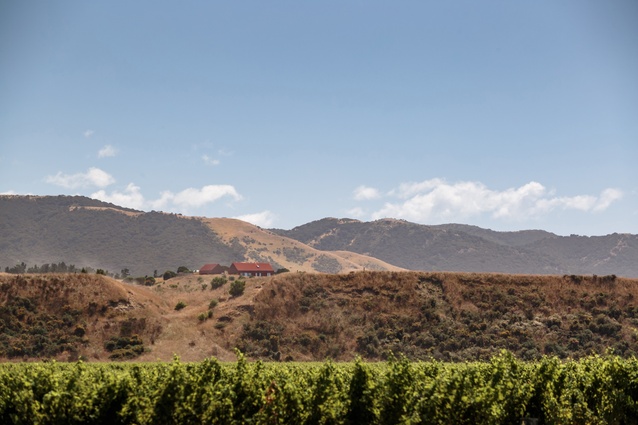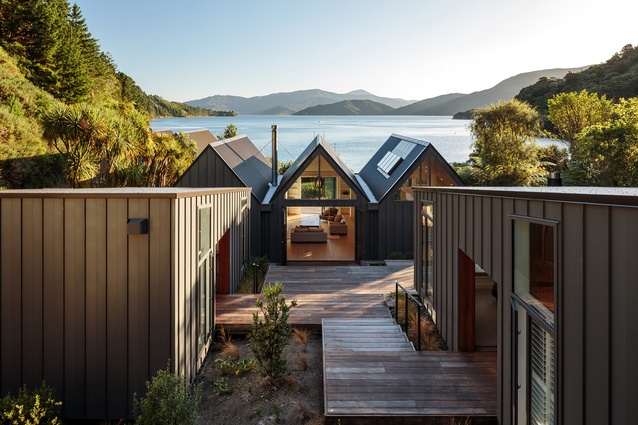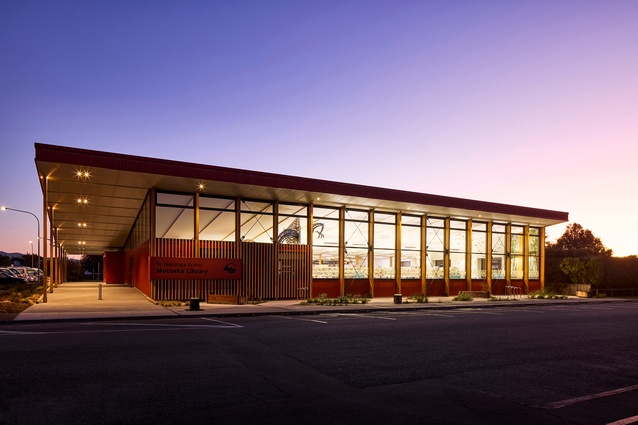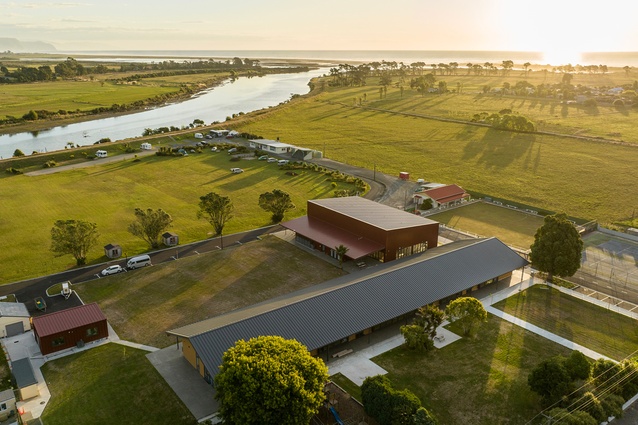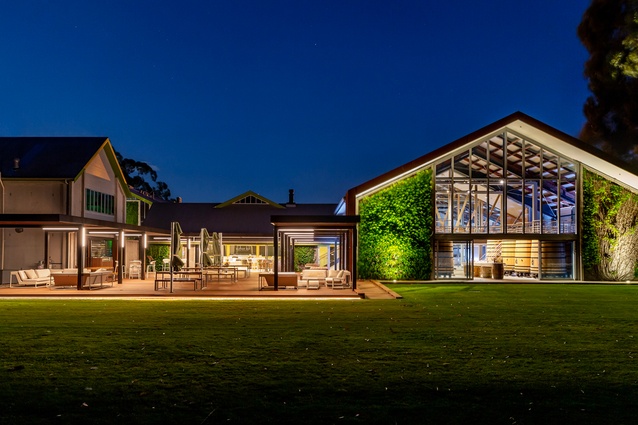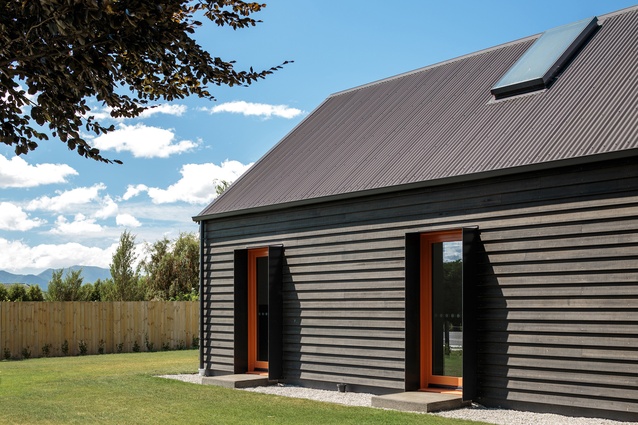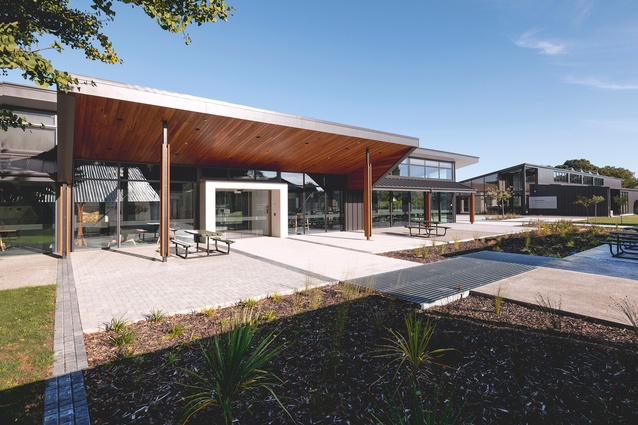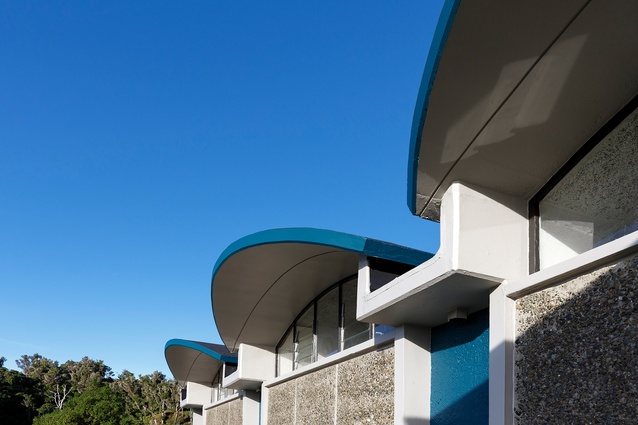Winners: Nelson and Marlborough Architecture Awards 2023
An epic wine cellar, a beautiful new school for just 80 children and sports clubrooms with quirky colour detailing has taken out the year’s top architecture awards for the Nelson Marlborough region.
Eleven architecture projects across seven categories, were named Te Kāhui Whaihanga New Zealand Institute of Architecture Local Awards winners at an event on Friday 26 May at The Suter Art Gallery in Nelson.
Rural Workshop Architecture won three awards across three categories. Their Real Workspace, an office space that integrates wellness architecture practices, won in the Commercial Architecture category; Awatere Hilltop House, a beautifully isolated home that mirrors the surrounding hills, won in the Housing category; and Head of the Bay house won in the Housing — Alterations and Additions category, for a understated remodel of a bunk room and bach in the Marlborough Sounds.
Jerram Tocker Barron Architects took away three awards. New Zealand Wine Centre — Te Pokapū Wāina o Aotearoa, a research and education centre for grape and wine research at the local Institute of Technology, won in the Commercial category, while Maitahi Quarter Townhouses, a multi-unit project that overlooks Nelson’s Maitai River, won the Housing — Multi Unit category. And Motueka Public Library — Te Noninga Kumu, inspired by the traditional forms of rural farm buildings, won in the Public Architecture category.
Karamea Area School, designed by MOAA Architects, was deemed the winner of the Education category. The new school is a utilitarian and beautiful community hub for the small town of Karamea (population approximately 400), and a school for Years 1-13.
William Samuels Architects’ Studio House, a unique 42m² home with a very tight construction budget, showed a residence can be affordable and architecturally significant, by winning an award in the Housing category.
Cellar One, created for Cloudy Bay Vineyards by Paul Rolfe Architects and a beautiful winemaking facility and dining area, won the Commercial Architecture category.
Finally, two buildings received Enduring Architecture awards: Alpine Lodge, St Arnaud (1984) by architect Ian Jack, a lodge made up of apartments, rooms, a restaurant and a playground; and Pohara Hall in Golden Bay (1971), a 1970s’ gem by the late modernist architect Alex Bowman.
A jury of four judges — Siân Taylor of Team Green Architects, Jonathan Fraser of Studio Pacific, and architect Sarah Pickens — assessed this year’s projects, and the jury was convened by architect Min Hall.
“All of the projects we visited responded to the comparatively rural nature of the region and we tended to see buildings that reflected that characteristic quite strongly, even in the residential categories. The architects have taken the rural vernacular as a guide, using simple pragmatic forms,” says Min Hall.
“There was also an encouraging consciousness of environmental and sustainable issues overall, and we were pleased to see much more openness to acknowledging te ao Māori in the public projects.”
The winning projects are:
Housing
Awatere Hilltop House by Rural Workshop Architecture

A simple yet strong concept of two red sheds on the edge of a hilltop maximises the expansive sea-to-mountains views to the south, while containing a small, sheltered courtyard to the north. Clever internal planning optimises a tight footprint to ensure the house feels both welcoming and roomy. The overhanging corrugate roof/wall intersection removes the requirement for gutters, allowing rainwater to drip into a concealed drain and disperse naturally.
The architect has carefully considered form, construction and services to ensure this house is warm and uses minimal energy. This is a clever and attractive design using compact forms to respond strongly to client, site and environment.
Resene Colour Award
The use of iconic Resene Pioneer Red on these sheds transforms a good design into a memorable and pleasing form that references an historic vernacular.
Studio House by William Samuels Architects
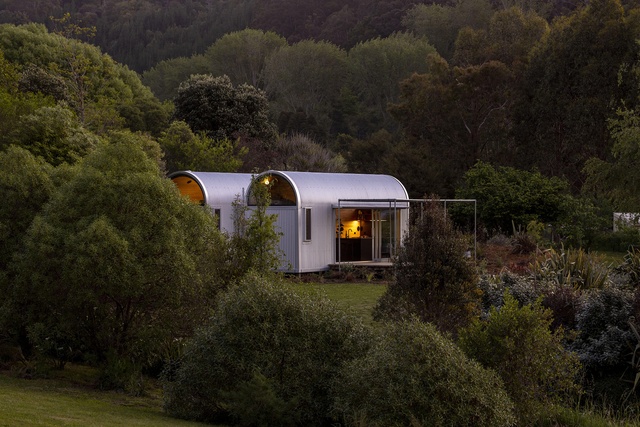
Studio House is comprised of two moveable structures, distinctive for their conjoined hooped form and clever use of a tight footprint. At only 42m2, the living area spans the two volumes, resulting in a surprisingly generous space. Judicious use of materials is a hallmark of the design, from the corrugated cladding to the use of scaffolding for the exterior canopy. Detailing is well considered yet economical: hoop windows are crisply detailed and the loft creates a snug sleeping platform for visitors. Studio House presents a compelling way forward — an economic and considered solution to the residential genre.
Housing – Alterations and Additions
Head of the Bay by Rural Workshop Architects

This Marlborough Sounds renovation features a fully reclad triple gable form that opens up to two new monopitch pods to the north. Existing gable tops have been fully glazed, drawing light into the open-plan interior, while the new sleeping pods provide ample room for extended family. Although compact, the pods are well planned and crafted to ensure good use of space.
The positioning of the new pods creates a pleasant stepped outdoor living space sheltered from southerly winds. Steps of varying heights create casual seating, while the timber decking serves to connect all buildings to each other and the foreshore.
Housing – Multi Unit
Maitahi Quarter Townhouses by Jerram Tocker Barron Architects

A site with planning and flooding constraints required an architect who could navigate and transform these challenges into opportunities. The result is a set of attractive and functional townhouses overlooking the river, introducing a much-needed typology to a (currently) underpopulated town centre.
The clever use of adjustable vertical louvres allows occupants to enjoy views while avoiding being overlooked by close neighbours. Internal planning and storage have been well-considered to ensure the interior is robust, light, spacious and well-proportioned.
High-quality medium density homes such as these will draw people back into the city, which encourages a more sustainable lifestyle.
Public Architecture
Motueka Public Library – Te Noninga Kumu by Jerram Tocker Barron Architects

Essentially a building in the round, the Motueka Library responds effectively to its suburban setting. The exposed laminated timber structure activates the street edge, while the response to the public domain is more intimate. Punched window openings give glimpses through to the adjacent Japanese gardens and bi-fold doors lead to exterior reading decks.
Toi Māori throughout brings visibility to mana whenua and enhances a sense of place and community connection. Robust external detailing, cladding and roofing reflect the nature of the community’s agricultural roots. Photovoltaic panels and natural ventilation are used effectively to manage operational efficiencies, and the judicious choice of materials has contributed to an uncomplicated interior finish.
Education
Karamea Area School by MOAA Architects
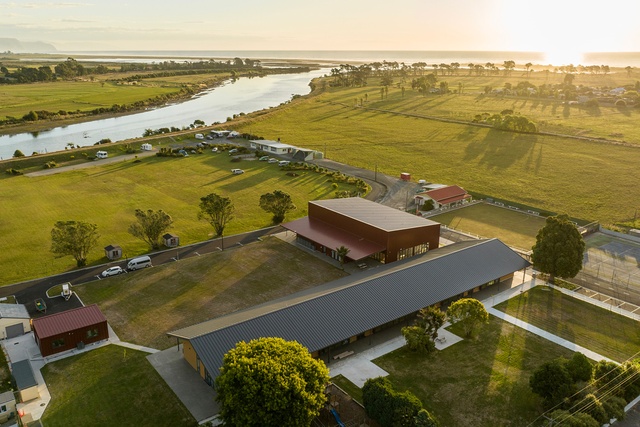
The new Karamea Area School is a deceptively straightforward response to place and brief. The old school has been replaced by buildings that frame three sides of the school’s playing fields. The main block, a 72-metre-long gable, reflects the pragmatic nature of local vernacular architecture — milking sheds, moss-drying sheds and modern tramping huts. Inside, offices, library and learning spaces flow easily from one to the next via the perimeter, where space is also provided for storage, bathrooms and sought-after window seats. Generous verandahs and porches allow for easy all-weather movement around and between buildings. The mono-pitched gymnasium is generously lit and provides a much-appreciated community facility.
Resene Colour Award
Strong blocks of colour — red, ochre and grey — emphasise the importance of the Karamea School as a community facility in an isolated town. Inside, clear timber finishes combine with colour and varied textures to create a bright, airy and calm atmosphere in what might be a challenging open-plan environment. Soft moss-green carpet and furnishings seem an appropriate choice on this cleared strip between the Kahurangi National Park and Tasman Sea.
Commercial Architecture
Cellar One, Cloudy Bay Vineyards by Paul Rolfe Architects
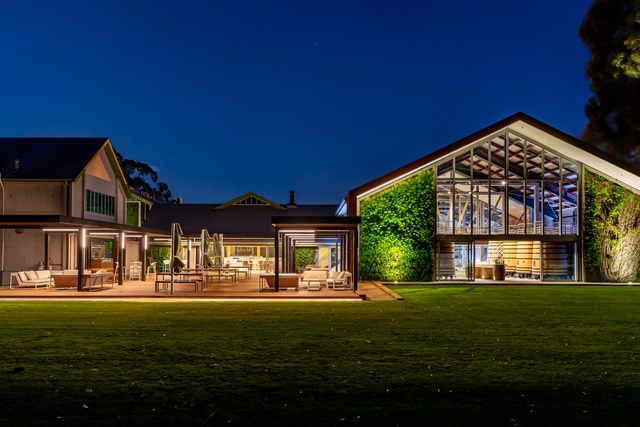
Cellar One represents a celebration of the winemaker’s art, with process being evident as a design driver, giving insight into the nuances of wine production while expressing mechanics and equipment geometries. Teamwork between architect, engineer, contractor and winemaker is obvious in the clever insertion of the glass viewing pod suspended over the production hall in a re-purposed agricultural space. The adjacent tasting galleries are artfully crafted to display the finished product.
Structural interventions are clearly expressed and give new life and light to an otherwise rigid concrete shell. Finely crafted timber joinery adds to the refined detailing.
The New Zealand Wine Centre – Te Pokapū Wāina o Aotearoa
by Jerram Tocker Barron Architects
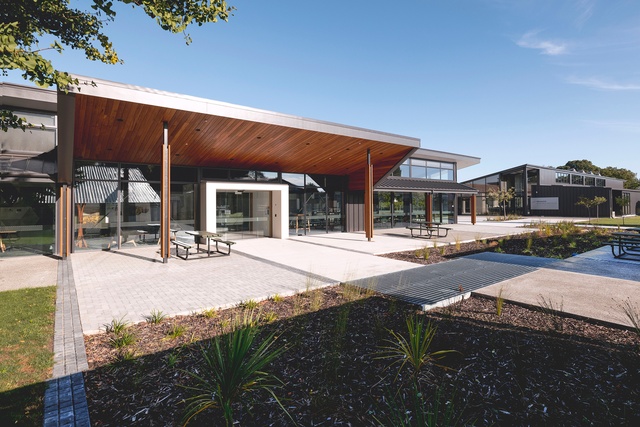
The Wine Centre exhibits a sensitive response to place and the wider environment, while providing a focal point for a number of disparate elements. Given a complex relationship between existing buildings, this new addition seamlessly draws them all together. The large verandah not only makes a strong entrance statement, as it draws users in from the surrounding courtyard, but also provides a collaborative public space. Clear pathways are created between existing and future buildings.
Inside, a series of communal spaces have been designed with a strong focus on acoustic performance. This is achieved using both ceiling and wall panels, creating an aesthetically pleasing and highly functional interior.
Resene Colour Award
Colour has been carefully introduced to reinforce the intended use of the New Zealand Wine Centre as a collaborative hub. Lush green carpet and folded plate ceilings lined with locally grown hardwood link all the spaces, while the super-structure, picked out in black, recedes. Grey and white triangulated acoustic panels occupy much of the meeting-room walls and help focus attention inwards to the sharing of ideas. The simple but sophisticated colour scheme is echoed in all furnishings, furniture and cabinetry.
Real Workspace by Rural Workshop Architecture
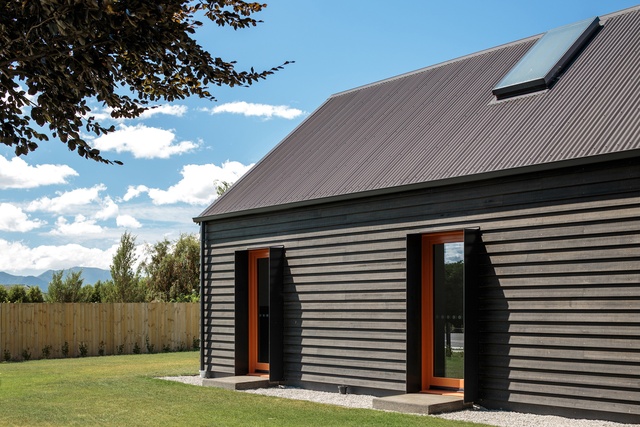
The modern interpretation of the rural shed houses a functional and pleasant workspace for multiple businesses. The dark weatherboard exterior is crisply detailed with steel eyebrows surrounding the recurring window/skylight combination. The interior is light and airy, creating a friendly and inviting workplace. Utilities are attached to the entry side in lean-to forms, ensuring the main space is clean and open to the pitch throughout.
The architect has used Structurally Insulated Panels, European joinery and low-energy mechanical components to create a well-detailed energy-efficient building. Material selections further emphasise sustainable choices through local sourcing.
Enduring Architecture Awards
Pohara Hall (1971) by Alex Bowman, Architect
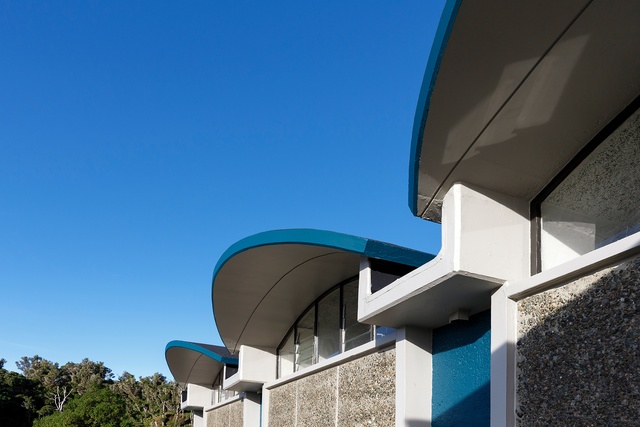
This iconic landmark is recognised and loved by many people in Golden Bay and beyond. With raised eyebrows to the road between Tarakohe and Pōhara, the community hall represents an era now passed. Funded by Golden Bay Cement and designed by architect Alex Bowman, the hall was built for community functions, dances and theatre events. The generous use of concrete speaks of its benefactor’s business interests. The precast panels with exposed aggregate, externally expressed columns and open-ended rainwater outlets between the softly curved roofs speak of the architect’s influence.
Alpine Lodge (1984) by Ian Jack, Architect

Firmly embedded in its mountain landscape, Lake Rotoiti’s Alpine Lodge is as relevant and popular today as it was 40 years ago. The architect’s challenge was to respond to the powerful setting, which was achieved through a carefully composed array of steep-pitched roofs, while also providing a human-scale refuge. Low walls and steep roofs spring from lush alpine gardens framing the main entry and public areas. Interior spaces are both intimate and uplifting. Dramatic dark-stained roof elements are offset by the warmth of rimu lining. Generous windows start low, often with window seats providing warm places to sit in the sun, while framing views to the beech forest and mountains beyond.
The NZIA Architecture Awards programme is supported by Resene and APL.

